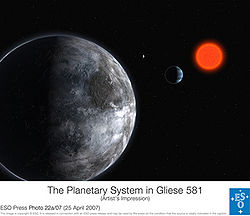Gliese 581
 There's something missing here… There's something missing here…This page is missing critical information of some kind. It might need a location, or names of people involved, or something else. It might be outdated. It might be a Wikipedia or SolStation data dump with little or no relation – or, worse yet, with contradictions – to the situation in Fenspace. It might have inconsistencies. It might even be missing multiple details. You can help FenWiki by expanding this page. |
| Gliese 581 | |
 | |
| Stellar characteristics | |
|---|---|
| Constellation | Libra |
| Right ascension (Epoch J2000) | 15h 19m 26.8250s |
| Declination (Epoch J2000) | −07° 43′ 20.209″ |
| Spectral type | M3V |
| Distance from Sol | 20.3 ± 0.3 ly |
| Other designations | HO Librae, HO Lib, BD−07°4003, GJ 581, HIP 74995, LFT 1195, LHS 394, LPM 564, LTT 6112, NLTT 39886, TYC 5594-1093-1, Wolf 562. |
| Planets | Gliese 581 b, Gliese 581 c, Gliese 581 d, Gliese 581 e, Gliese 581 g |
Gliese 581 (pronounced /ˈɡliːzə/) is a red dwarf star with spectral type M3V, located 20.3 light years away from Earth in the constellation Libra. Its mass is estimated to be approximately a third of that of the Sun, and it is the 87th closest known star system to the Sun. Observations suggest that the star has at least four planets: Gliese 581 b, c, d, e.
The star system gained attention after Gliese 581c, the first low-mass extrasolar planet found to be near its star's habitable zone, was discovered in April 2007. It has since been shown that under known terrestrial planet climate models, Gliese 581c is likely to have a runaway greenhouse effect, and hence is probably not habitable. However, the subsequently discovered outermost planet Gliese 581d is firmly within the habitable zone. In April 2009, the discovery of exoplanet Gliese 581 e, at that time the closest-known in mass to Earth, was announced.
(Data from Wikipedia)
In September 2010 A team of astronomers using equipment from the Keck observatory announced the discovery of an Earth sized planet, Gliese 581g, orbiting Gliese 581 in the star's liquid water zone.
Known Places in Gliese 581
- Gliese 581b
- Gliese 581c
- Gliese 581d
- Gliese 581e
- Gliese 581f
- Gliese 581g (called Zarmina's World by its discoverer)